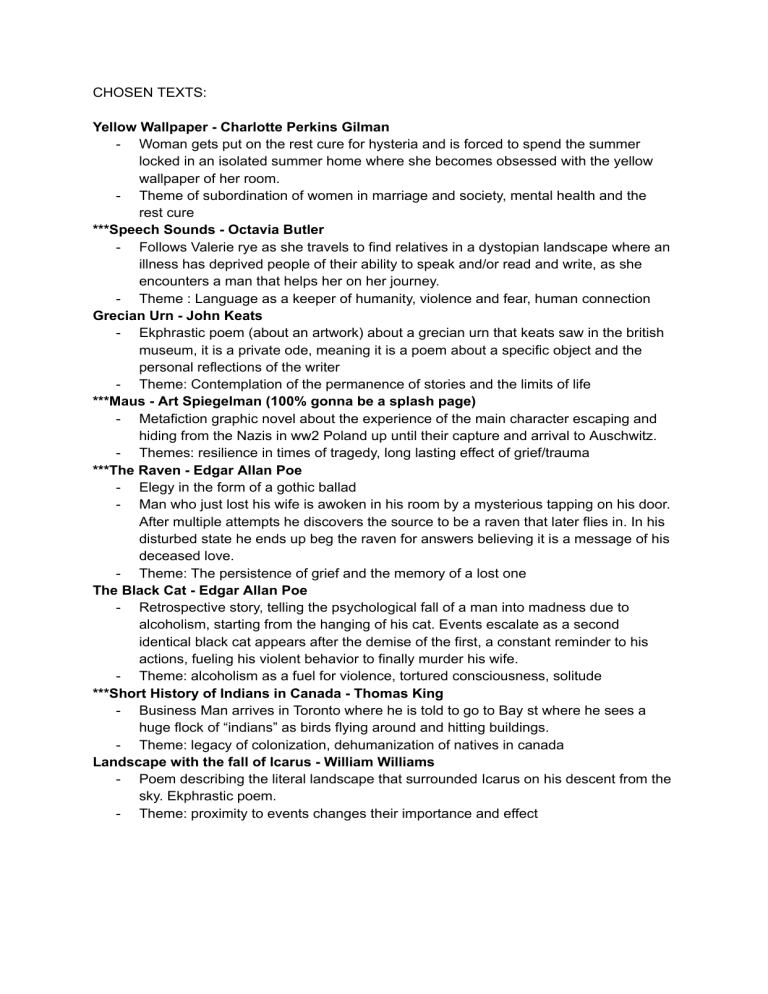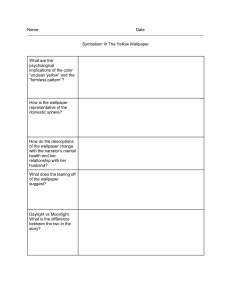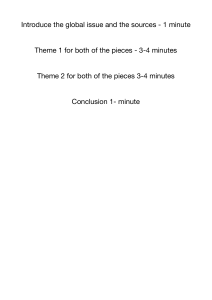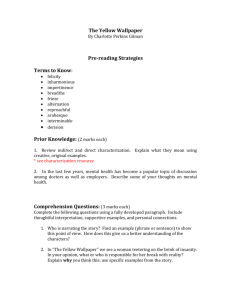
CHOSEN TEXTS: Yellow Wallpaper - Charlotte Perkins Gilman - Woman gets put on the rest cure for hysteria and is forced to spend the summer locked in an isolated summer home where she becomes obsessed with the yellow wallpaper of her room. - Theme of subordination of women in marriage and society, mental health and the rest cure ***Speech Sounds - Octavia Butler - Follows Valerie rye as she travels to find relatives in a dystopian landscape where an illness has deprived people of their ability to speak and/or read and write, as she encounters a man that helps her on her journey. - Theme : Language as a keeper of humanity, violence and fear, human connection Grecian Urn - John Keats - Ekphrastic poem (about an artwork) about a grecian urn that keats saw in the british museum, it is a private ode, meaning it is a poem about a specific object and the personal reflections of the writer - Theme: Contemplation of the permanence of stories and the limits of life ***Maus - Art Spiegelman (100% gonna be a splash page) - Metafiction graphic novel about the experience of the main character escaping and hiding from the Nazis in ww2 Poland up until their capture and arrival to Auschwitz. - Themes: resilience in times of tragedy, long lasting effect of grief/trauma ***The Raven - Edgar Allan Poe - Elegy in the form of a gothic ballad - Man who just lost his wife is awoken in his room by a mysterious tapping on his door. After multiple attempts he discovers the source to be a raven that later flies in. In his disturbed state he ends up beg the raven for answers believing it is a message of his deceased love. - Theme: The persistence of grief and the memory of a lost one The Black Cat - Edgar Allan Poe - Retrospective story, telling the psychological fall of a man into madness due to alcoholism, starting from the hanging of his cat. Events escalate as a second identical black cat appears after the demise of the first, a constant reminder to his actions, fueling his violent behavior to finally murder his wife. - Theme: alcoholism as a fuel for violence, tortured consciousness, solitude ***Short History of Indians in Canada - Thomas King - Business Man arrives in Toronto where he is told to go to Bay st where he sees a huge flock of “indians” as birds flying around and hitting buildings. - Theme: legacy of colonization, dehumanization of natives in canada Landscape with the fall of Icarus - William Williams - Poem describing the literal landscape that surrounded Icarus on his descent from the sky. Ekphrastic poem. - Theme: proximity to events changes their importance and effect COMPARISONS FOR ESSAY Literary device of UNRELIABLE NARRATOR Yellow wallpaper and Omelas Both “Yellow wallpaper” and “omelas'' are told by unreliable narrators that convey a hidden reality to readers. However, while in “yellow wallpaper” it is conveyed through journal entries by the narrator, in “omelas” it is through a story-telling format. This is significant because both lead readers to reflect on how societal consensus on what is right is not always ethical. p1) unreliable narration as used in both - vision as the objective truth - Jane is unreliable due to her deteriorating mental sanity (opening up about her condition at beginning, we start to realize the issue) - omelas because of his confusing way of talking of the town, clearly hiding some deeper intent (“i do not know the rules and laws”, repeat “how can i tell you about the people of omelas?”) - Jane shows the reality of rest cure consequence / narrator shows real cost of happiness - Similarities: they both use detailed imagery (wallpaper vs town) to convey their vision and a desire to be believed - Wallpaper: the color, twists and turns, descriptions of the women in the wallpaper shaking it - only she can see them and their existence conveys her decreasing sanity - conversations with her husband where she gets dismissed - Omelas: the festivities and general look of the town are described in great detail, positive connotation of words (great, splendid, joyous) - emphasizing the joy and - Persuasive tone, repeating question, and acknowledging the craziness of the description so that we can believe them - the need to be believed and the imagery to emphasize this desire calls almost for desperation, readers are left to realize the implication of the reality they convey and reflect on where it stems from. p2) yellow wallpaper - Do it to show her loss of mental sanity - through journal we are told the view on the wallpaper and literally read her progression from her words - Gorey image of the strangled head shows her view of the effect of her ‘jail’ and her subconscious suicidality from being stuck there - a helpful insight into the subordination of women in society - Can only express herself in the journal - mentions multiple times how it is an ease on her mind and cannot talk ab this with anyone (bring back convo w husband) - Her viewpoint tells us how her relationship is in her eyes (beginning paragraph, we see the dismissal and infantilization) although she cannot admit it (always saying how he is such a good person bc he takes care of her) - Readers are left to reflect on the highly regarded institution of marriage and how women were subordinated by husbands/males to the point where it could make them develop mental instability p3) in omelas - Introduce narrator as above all being - telling readers a story directly - it attempts to convince readers of the perfect reality of the town - Large use of imagery to describe the town and rhetorical questions to readers - To draw on the good of the society - repeated questions about how to describe people is their way of rooting the existence of the town and reassuring readers that it is real - Takes a long time to get to child, and puts them down as they describe them (born defective, can’t tell if boy or girl, picks its toes) - Make them seem crazy or inhuman to justify treatment - List all good things it brings after to cover up the heartbreaking image - BUT redirects image to readers asking if now they are credible, because of their selfishness - Allegory of colonialism, suffering of the small for wealth and prosperity of the rest: ethical implication that we live in - Bridging the utopia of omelas to the real world prompts readers to realize that they live in this condition and how we have just come to accept it as a society Theme of GRIEF The Raven and story of your life - Expressed as flashbacks in story of your life - Personified in the raven - Both shown as persistent Both “the raven” and “story of your life” present a common theme of the persistence of grief, however, “the raven” expresses grief with the use of prolepsis while “story of your life” uses analepsis. This is significant because both stories demonstrate how loss can affect one's mental health(thinking). Theme of GRIEF The Raven and Maus - Both shown to affect mental health - Vladek displaces his grief to his behavior although sometimes cries - Raven man is instead overwhelmed by it and loses his sanity Both “The Raven” and Maus explore the effect of grief on the mental health of those experiencing it. However, while Vladek in Maus displaces his grief to his behavior, the main character in “The Raven” fully absorbs it which leads him to losing his sanity. This is significant because it helps readers realize the complexity of dealing with grief. Literary device of IMAGERY - Extended use of imagery (wallpaper and town) to convey this single vision of narrator - used to deceive and embellish to justify the torturing of the girl (omelas) Of wallpaper used as a representation of her mental and social situation Literary device of Satire - Indians in canada where natives portrayed as birds to dehumanize them - Maus uses anthropomorphism to emphasize discrimination of Jews (drawing in animal associations) and racial segregation - Both use these animal representations to satirize (make us laugh to then realize the disturbing events that they are portraying)



